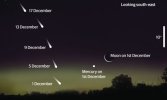Some advice on how to see the comet if it survives its fiery encounter with the sun on Thursday. Even it breaks apart it should provide a spectacular but brief show...

If Comet Ison survives its trial by fire as it buzzes the sun on Thursday, it should light up night skies during December. Unfortunately, the comet will not be visible from the southern hemisphere.
"Comet C/2012 S1 Ison reaches perihelion [its closest approach to the sun] around 18:40 GMT on 28 November. After that date, and assuming it survives its close encounter with the sun, the comet will re-emerge into the morning sky once more but may also be visible low in the evening twilight too. On the morning of 29 November, the comet will remain perilously close to the sun and be lost to the dawn twilight. The same is probably true of the evening view too despite Ison hopefully being pretty bright at this time.
"Things gradually get better in terms of position as we head into the first week of December, the comet first becoming accessible from 2 December onwards, low in the east-southeast before sunrise and low in the west-southwest after sunset. If the comet develops an impressive tail – something we're all hoping will happen – then this will stand up in the morning sky but lay flatter to the horizon in the evening.
"Binoculars are probably the best way to locate the comet at the start of December but take care to make sure the sun is below the horizon when sweeping around."
NEVER observe the sun through any form of optical instrument. Permanent blindness can result.
"The evening/morning viewing sessions continue through early December with the comet slowly pulling away from the sun, as it moves further into the northern part of the sky. As the month progresses, so the comet will appear fainter, probably approaching naked eye threshold at the end of the month. A large dust tail may help keep it in view though.
"The moon interferes with the morning session from the middle of the month onwards too. After 22 December, Ison will be circumpolar, never setting from the UK. On 7 and 8 January, the comet will be close to the North Star, Polaris. Using a pair of binoculars, look at Polaris and the comet should be visible in the same field of view."
Upon its discovery in 2012, Comet Ison was predicted by some to become "the comet of the century". As I pointed out here, that looks highly unlikely. Instead, the most we can sensibly hope for is that Ison provides the best view since Hale-Bopp lit the skies in 1997 – but nothing is guaranteed.

If Comet Ison survives its trial by fire as it buzzes the sun on Thursday, it should light up night skies during December. Unfortunately, the comet will not be visible from the southern hemisphere.
"Comet C/2012 S1 Ison reaches perihelion [its closest approach to the sun] around 18:40 GMT on 28 November. After that date, and assuming it survives its close encounter with the sun, the comet will re-emerge into the morning sky once more but may also be visible low in the evening twilight too. On the morning of 29 November, the comet will remain perilously close to the sun and be lost to the dawn twilight. The same is probably true of the evening view too despite Ison hopefully being pretty bright at this time.
"Things gradually get better in terms of position as we head into the first week of December, the comet first becoming accessible from 2 December onwards, low in the east-southeast before sunrise and low in the west-southwest after sunset. If the comet develops an impressive tail – something we're all hoping will happen – then this will stand up in the morning sky but lay flatter to the horizon in the evening.
"Binoculars are probably the best way to locate the comet at the start of December but take care to make sure the sun is below the horizon when sweeping around."
NEVER observe the sun through any form of optical instrument. Permanent blindness can result.
"The evening/morning viewing sessions continue through early December with the comet slowly pulling away from the sun, as it moves further into the northern part of the sky. As the month progresses, so the comet will appear fainter, probably approaching naked eye threshold at the end of the month. A large dust tail may help keep it in view though.
"The moon interferes with the morning session from the middle of the month onwards too. After 22 December, Ison will be circumpolar, never setting from the UK. On 7 and 8 January, the comet will be close to the North Star, Polaris. Using a pair of binoculars, look at Polaris and the comet should be visible in the same field of view."
Upon its discovery in 2012, Comet Ison was predicted by some to become "the comet of the century". As I pointed out here, that looks highly unlikely. Instead, the most we can sensibly hope for is that Ison provides the best view since Hale-Bopp lit the skies in 1997 – but nothing is guaranteed.
